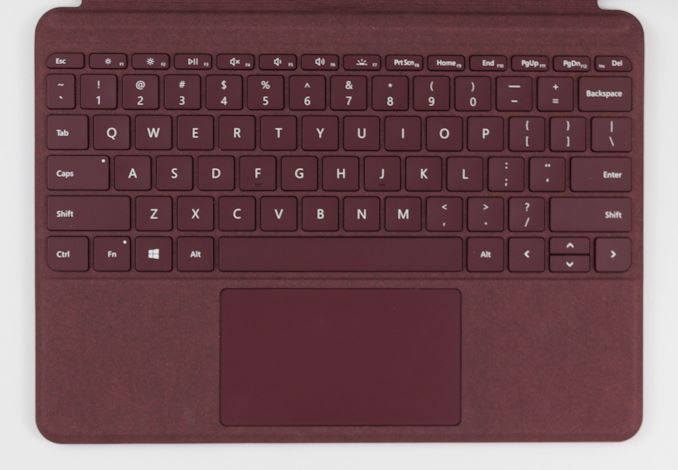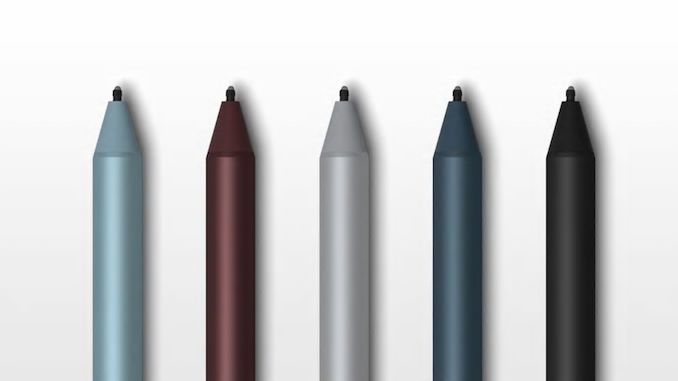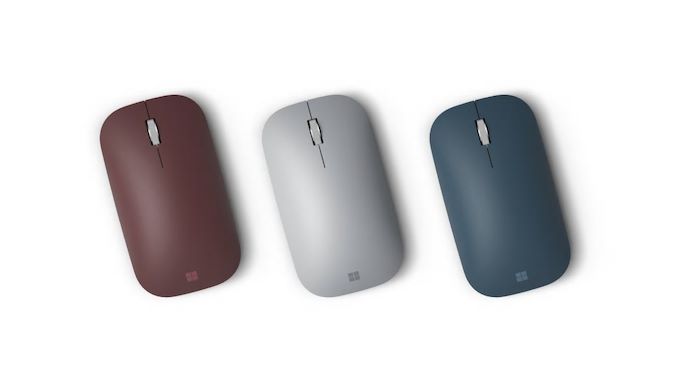The Microsoft Surface Go LTE Review: Unmatched Mobility
by Brett Howse on January 17, 2019 8:00 AM ESTDesign
There’s no mistaking the Surface Go for any other product. Microsoft has done a great job refining their tablet design over the years, and the Surface Go benefits from almost all of that refinement. It features the same silver magnesium finish as the rest of the lineup, and the distinctive chrome Microsoft logo on the rear. There’s a plastic strip at the top which lets the RF through, and the kickstand which has been the defining design element of all Surface tablets. The Surface Go features the same infinitely adjustable hinge as the Pro, and it opens wide enough to be used as a drawing surface.
The Surface Go features nicely rounded edges, which was a design feature Microsoft introduced with the Surface Pro 5 in 2017, and it gives the design a software in-hand feel compared to the previous models. The Surface Go is also slightly thinner than the Surface Pro 6, although almost imperceptibly so.
The one design feature that has unfortunately not made it into the Surface Go is the thinner display bezels found on many recent devices. By today’s standards, the bezels on the Surface Go are thick, and it would have been nice to see a larger display in this size of chassis. The bezels do give you somewhere to hang on if using the Go as a tablet, but they don’t need to be this large to achieve this result, and make the Go look like a somewhat dated design despite it being brand new. In reality the bezels are not much wider than the Surface Pro 6, but with the smaller display, the proportion of bezel to display is higher.
On the top bezel is the front facing camera, which also offers IR for Windows Hello facial recognition, and the Windows Hello is very accurate, even if it’s a touch slower to use on this model. For video conferencing, the Surface Go offers a 5 MP camera on the front which can do 1080p video. The rear camera is an 8 MP auto-focus unit. Unlike some of the more expensive Surface products, the Surface Go features just a single microphone, so it likely won’t be as good for long-range Cortana.
All of the ports are on the right side of the device, with the Surface Connect port at the bottom, and the USB Type-C and headset jack closer to the top. If there’s a Surface redesign, it would be nice to see the headset jack find a better location to avoid the cable being in such an awkward spot, although the Go does offer the headset jack quite a bit lower than the Pro does. There’s also a microSD slot under the kickstand on the right side.
The left side has only one opening, and that is for the nano SIM card.
Despite the Surface Go being a less-expensive model, it really feels like a smaller version of the Pro, with the same, fantastic kickstand design, and the same magnesium chassis. The only real knock against the Go’s design is the display bezels, which harken back to an earlier era. The real advantage for the Surface Go is the smaller size, and much lower weight than the Pro. A Surface Pro 6 is 770 grams for an i5 model, and the Go is just 515 grams, or 33% lighter. That makes for an extremely portable PC.
Accessories
As with all Surface tablets, the Surface Go isn’t really complete without some accessories.
Surface Go Type Cover
Microsoft offers several choices for the Type Cover, which is the one essential accessory for any Surface Go. Although there is sometimes some criticism about why this is a separate purchase, it gives the buyer the ability to customize their Surface Go’s color scheme. Some retailers also offer bundled purchases, so you can have it either way.
The base Type Cover is the standard black model, which offers a soft plastic cover around the built-in keyboard, and it retails for $99. Those that want a bit more color, and a bit more refinement, can go for a Signature Type Cover, which is wrapped in Alacantara just like on the Surface Pro, and is available in Burgundy, Platinum, or Cobalt Blue. The Signature Type Covers retail for $129, and for $30 are a worthwhile upgrade if you are in the market. The Alcantara gives a great feel, especially when the device is closed, and being a synthetic fabric, holds up pretty well over time.
The trackpad offered on the Type Cover is excellent, with a smooth glass top that offers great precision. If you recall the original, tiny trackpads Microsoft used to offer, this is perhaps the most obvious improvement. Despite the smaller dimensions of the Surface Go, the trackpad is well-sized.
The downside of moving to a smaller form factor in the Surface Go, compared to the Surface Pro, is that they keyboard is also shrunk to accommodate the smaller dimensions of the device. Although they keyboard offers the same edge-to-edge keys as the Pro, that edge-to-edge dimension is small enough that the keyboard is fairly cramped. If you have large hands, this is likely not the device for you because of this. If you don’t mind a smaller keyboard, the quality of the keyboard, and the key feel, coupled with the three levels of backlighting, make this a great keyboard, but the small size takes a lot of getting used to, and causes a lot of mis-types when adjusting.
Surface Pen
Although not necessarily as essential as the Type Cover, the same Surface Pen as the rest of the Surface lineup is also available for the Surface Go, and the pen can be magnetically attached to the left side for storage, although the rounded edges don’t make it quite as tight of a fit as on the Pro. The pen can also be purchased in the same color scheme as the type covers, which means black, burgundy, platinum, or cobalt blue are all available to color coordinate with the cover.
The Surface pen is one of the best writing devices available on a tablet, with 4096 pressure levels, tilt support, and very low latency. That coupled with the thin display stack, makes the Surface Go an excellent choice for notes, and the writing experience is really a great experience. The Surface Pen tips are also interchangeable, and you can purchase a set of tips with various thicknesses, and Microsoft continues to offer a great tip feel, where there’s just enough traction on the glass that it makes you feel like you’re connected to a real pen.
Surface Mobile Mouse
If you prefer to use a mouse over a trackpad, the Surface Mobile Mouse is a Bluetooth connected mouse with seamless scrolling, a compact form factor, and the same color options as the rest of the accessories to coordinate. It features the Microsoft BlueTrack technology and the battery life from the two AA batteries is rated for up to 12 months.

















79 Comments
View All Comments
thewishy - Thursday, January 17, 2019 - link
I've had a non-lte 8/128gb since November. I have a work Dell XPS 15, which is hugely powerful but has shockingly bad battery life and is utterly unsuited to use on a plane - so I have another machine to do heavy lifting.This machine gets used on work trips where I don't need much more than an RDP client to a lab, work, excel and OWA, and I want something to entertain me on long flights and evenings if I feel like.
It works brilliantly on the tray table in economy, the battery life might be "Poor", but with a 99wh USB-PD power pack the endurance of 16-24hrs. Given the cost and ease with which the life can be extended, 6hrs of browsing / word and 8-9 hours of movies without the power bank is reasonable IMHO. I wouldn't want to make it heavier for the sake of enhanced endurance. USB-PD charger allows me to charge phone, laptop and power bank with a single charger.
Performance is... slow. It's very noticeably less snappy than anything else I use, but doesn't crawl to a halt under load (For example, no problems with it swapping out). Under light use it's fine, and it works fine for light games.
Screen is sharp, a mouse transforms usability for office use. Keyboard is ok after a short adjustment period, but the trackpad can get in the way occasionally.
Bezel is a little large, but does make it easy to hand hold.
Lack of USB-A is a bit of a pain if you have a Yubikey, and a second USB-C would be lovely if you're using that for charging.
As my only machine it would drive me nuts, but for a specific use case it's been perfect.
TheinsanegamerN - Saturday, January 19, 2019 - link
The interior design of the Go is pathetic for battery packaging. You wouldnt have to make it thicker to fit more battery in there.Trefugl - Thursday, January 17, 2019 - link
Any idea how the CPU performance compares to the original Surface Pro (16:9 one)? I have one of those that I still use for travel, but it's definitely showing its age and the pen input isn't nearly as good as modern surface tablets, and the screens are nearly as nice either... Ideally I'm hoping that I could do some light editing of raw photos in lightroom while on the go, even if it's mildly painful... still better than trying to do it on my phone or carrying around something much bigger.Brett Howse - Thursday, January 17, 2019 - link
Hi Trefugl. I'll reference you to our Online Bench which was also linked in the article:https://www.anandtech.com/bench/product/1207?vs=23...
HStewart - Saturday, January 19, 2019 - link
I also have original Surface Pro and rarely use it - even though it performance is around i7 Y CPU.A good link to compare cpus is the following
https://cpu.userbenchmark.com/Compare/Intel-Pentiu...
It going to be really interesting to see Lakefield - it will like beat the Surface Pro 1 cpu in performance and have extreme battery life - this will be perfect for LTE companion
HStewart - Saturday, January 19, 2019 - link
Computer performance changes over time - I did use my Surface Pro 1 for photoshop and even Lightwave - but new CPU's today make a big difference.eastcoast_pete - Thursday, January 17, 2019 - link
Interesting device, somewhat overpriced. I really wish MS would go further on the mobility aspect and provide a significantly (50% bigger) larger battery. Even with 100 g more weight, it would still be light enough to carry around. Always connected shouldn't mean being plugged into an outlet after just a few hours.tmanini - Thursday, January 17, 2019 - link
"Microsoft also color calibrates all of its displays"I didn't find a handy reference article for this, so I can't confirm the statement or what exactly is done. But even if they do 'something' before it is boxed up, that calibration will drift in short order and essentially become useless. (if you plan to rely on it)
melgross - Thursday, January 17, 2019 - link
That’s not true. It used to be true in the days of the crt, but not now. Apple also calibrates all of its displays, including those in the iMac, and it’s pretty stable. That doesn’t mean that several years later it’s still perfect, but it’s pretty close, even then.The thing about these though, is that they’re just sRGB, which isn’t saying much these days.
anactoraaron - Thursday, January 17, 2019 - link
Exactly this. What exactly is the point of having a calibrated accurate display for maybe 1 month? Panels drift the most in the first year.The other thing that happens not just here at AT is these notebooks and tablets being touted as 'for image and video professionals' just because the display is accurate out of the box. This needs to stop.
Any system that lacks a display osd/hardware rgb channel/brightness/contrast adjustment isn't suited for any professional. Software can only do so much (making adjustments through Intel graphics software is awful) and for folks that absolutely need color accuracy (longer than 1 month out of the box) need the ability to adjust color channels, brightness, and contrast at the hardware level. I had a surface pro, and over time software couldn't properly calibrate it anymore. Sold it recently and went back to desktop, mobility be damned.